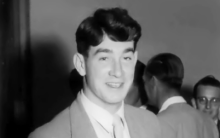|
My first days of wine commenced in February, 1951.
 
|
My first task was helping at the grape sampling station situated between roadside tanks H.M.C. 102 and 103. A deemed representative sample of grapes was collected from each load and tested for the sugar level using the Baume scale. This result was given to the weighbridge operator and recorded on the shareholder's docket. The top layer of most loads were usually graced with a few ripe buckets of grapes which enhanced the return. There was a bonus payment scale based on sugar content. At this time production was principally the making fortified wines, fortifying spirit and brandy. Table wines, both red and white were a small part of the make.
|
My next introduction was to the laboratory and the methods for determining levels of sugar (Baume scale, hydrometer), specific gravity (hydrometer), alcohol (Proof Scale, brass and glass hydrometers, plus Dujardin & Salleron Ebulliometer), titratable acid (NaOH titration), total sulphur dioxide (Iodine and Sodium thiosulphate titration), pH (Cambridge Potentiometer). Then followed the introduction to the preparation of standard solutions using the Sartorious Beam Balance. It was a great test of patience learning how to make the best of three swings on each side of the base pointer! The laboratory had some heating and cooling facilities as well as a refrigerator and it was most important to check your reference solutions fortnightly. With the large volumes and types of wine in stock we had to make sure the analyses were the real values. It was quite a learning curve. Bench burners were fuelled using fortifying spirit in a pressure pot. I guess it would not be allowed today. Similarly the asbestos clad wire mats under the flask to distribute the. flame.
In the 1952 vintage I graduated to No.1 Cellar to test the Baume and temperature of all the tanks in the morning and afternoon. Doug Collett then would decide what movements of the product were required. I can still remember the cellar being secured by sliding doors over the weekend period. I would open the door on Saturday and Sunday mornings at the northwest end of the building in mid March and there were the aroma’s of all the grape varieties in the cellar that poured over the top of the tanks entrained in the flow of carbon dioxide. It was a smorgasbord of grape odours which included Sultana, Currants, Pedro, Palomino, Semillon, Rosaki (Malaga, Waltham Cross), Trebbianno (White Hermitage), Gordo, Frontignan, Shiraz, Grenache, Mataro and Doradillo. The outside ambient temperature at 8 A.M. would be 9-12°C and inside the cellar, a warm 20-25°C. I will always remember that impression.
By this time I had worked in most sections and thought I should record the layout of the premises commencing from the Berri (east) end. I apologise if I repeat some of my comments that I made earlier.

With reference to the above photo shot in 1947-1948 - No. 2 Ferment Cellar is featured at the north-east section of the property next the Sturt Highway with Berri Township 7 kilometres east from the bottom of the photo. Immediately east and south of No.2 Cellar are chittle and ash heaps from the boilers.
On the left of the chittle and ash heaps is the water supply channel running west to the Pump-House from the 90 foot channel.
Left of the Pump-House in the foreground is the Tarac Berri Pty Ltd vineyard and west above the vineyard is the Tarac premises. Directly east of the Bond Store was the Tarac premises. Mr. A. J. Allen had secured a contract with the winery to process the spent skins and seeds. In return Tarac would ferment the residual sugar in the grape marc and distil the wash to an agreed alcohol content and return to Berri. This product was known as "low wines" and was further distilled in the three pot rectifiers that were in place in 1951-1953. Tarac Berri Pty Ltd at this time was managed by Mr. Norm Mader.
South of the Tarac Premises are wood stacks and above west of those are the "Lily Ponds" that stored the effluent discharges from the Winery since 1919 and Tarac since 1938.
Immediately west and above the Tarac complex is the Bond Store which occupies two levels. The ground floor with a steps down of approximately 1.5 meters to where the large timber vats were housed. This ground floor split level area contained a collection of oak, plus Jarrah and Karri casks and vats. You could say it was a growth area for some 30 years. Many of the Oval Casks were War Reparation items.
|

